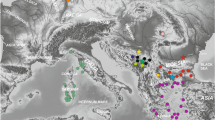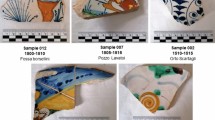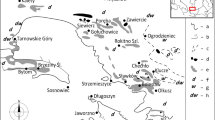Abstract
In this article, we study the provenance of the lead contained in 22 objects found in the excavations conducted since 1998 on the ancient site of Ilduro (Cabrera de Mar, Barcelona), located in the north-east of the Iberian Peninsula. A selection of 12 bronze coins and 10 lead objects recovered from households, workshops, and the public baths of the town were examined by means of Thermal Ionization Mass Spectrometry (TIMS) to document the lead supply and trade networks between, on the one hand, the indigenous peoples known in the classical sources as the Laeetani and, on the other, the Roman provincial administration and the societates that controlled the natural resources, their exploitation, and distribution during the Late Republic (second-first centuries B.C.E.). There is no doubt about Rome’s dependence on the considerable output of the lead and silver from Hispanic mines during this period; however, very little is known on how these mines supplied and affected the lives of the local communities in Hispania over the course of time. This study helps to cover this gap in the existing literature. The results show how all the coins have lead isotope ratios with homogeneous values compatible with an origin in the Spanish mining district of Cartagena-Mazarrón. The isotopic composition of the 10 lead objects is not homogeneous, and it is possible to identify three distinct clusters. The samples in cluster 3, which include all the artifacts from the bath complex, can also be attributed to the mining districts of Cartagena-Mazarrón, demonstrating that a single mining district supplied the lead required for these two specific initiatives: minting and the construction of the baths. However, the provenance of the lead in the remaining samples (workshops and households) remains unresolved and in some cases might be a consequence of remelting or the direct mixing of leads with different origins. The data from Ilduro points towards the existence of different lead supply patterns in the settlement: directly from the mining exploitations for the public enterprises in contrast to the recycling and mixing practices detected in households and workshops.












Similar content being viewed by others
Notes
Cato in 195 B.C.E., as described by Livy (34.21.7), seems to have introduced the payment of a vectigalia in the iron and silver mines. Díaz and Antolinos (2013: 536) suggested that the silver mines mentioned by Livy correspond to those in the area of Carthago Nova.
Diodorus’ reference (5.36.3) discussing the presence of Italic immigrants in Carthago Nova during the second century B.C.E. might be of interest to reinforce this hypothesis. On this topic, see Stefanile (2017) with bibliography.
Cf. Beltrán 2004: 151–175.
For a study of objects from NE Spain with chronologies between the eighth and the second centuries B.C.E, see the study by Rafel et al. (2010).
The authors of this article understand that the Late Republican settlement and the Iberian oppidum at Burriac, which coexisted for at least three quarters of a century (during the second half of the second century B.C.E. and the first quarter of the first century B.C.E.), functioned as a single urban entity economically (Sinner and Martí 2012; Sinner 2017) and linguistically speaking (Sinner and Ferrer 2016, 2018). Therefore and, based on the data currently available, both sites are included in this paper as belonging to ancient Ilduro. A similar interpretation in Olesti 2010: 29, footnote 14, Olesti 2017: 434. A detailed study of the oppidum at Burriac in Zamora 2006–2007; for a description of the main sectors of the Late Republican settlement, see: Martín and Garcia 2007; Sinner 2015: 13–20; Martín 2017.
LIMS is a wide data-base of approximately 1220 samples (Mediterranean area), which is based on the Oxford Archaeological Lead Isotope Database from the Isotrace Laboratory (Oxalid) (which includes lead isotopes of Spanish ores), the published literature (a summary in Montero 2018: 316-317), and, to a substantial degree, the measurements carried out by the LIMS itself. It is considered one of the most exhaustive isotopic databases available for the Roman period in the Mediterranean region (Clemenza et al. 2017: 1500).
Because lead was present in all the coins sampled, and because lead and copper have very restricted solubility in the solid state, with lead tending to form small lumps, which could falsify the results, we tested two different areas of each coin, in order to reduce the impact of this phenomenon. The areas probed, from which corrosion products had been removed, were about one mm2, and the depth analyzed was about 10 μm. For all the spectra, the acquisition time was 200 s. Zn, As, and Sb are not present in Table 10 because they were not present in any of the coins tested. The coins were analyzed by means of a portable X-ray fluorescence spectrometer, more specifically with an energy dispersive one (ED-XRF spectrometer) that allows to measure the number of X-rays emitted by the sample as a function of their energy. It consists of a low power X-ray generator, an X-ray detector, a pulse amplifier, a multichannel analyzer, and a computer. The X-ray generator has an anode target of palladium and a beryllium window of 150 μm of thickness and was powered with an accelerating potential difference of 40 kV and an electronic current of 0.1 mA. The detector is a Peltier cooled silicon drift (Amptek 123-SDD) which provides for every X photon revealed a current pulse of amplitude proportional to the photon energy. The detector has a surface of 25 mm2 and a thickness of 500 μm, a beryllium window of 12.5 μm and its energy resolution is 150 eV full width half maximum of the manganese Kα line at 5.9 keV. The current pulses are amplified by the pulse amplifier and send to the multichannel analyzer. Based on their amplitude, this device divides and counts the pulses in 1024 different channels. The result of this operation is a spectrum (number of photons versus photon energy) which is sent to the computer for storage and further analyses.
References
Arboledas L (2010) Minería y Metalurgia Romana en el Sur de la Península Ibérica: Sierra Morena Oriental. BAR International Series 2121, Oxford
Beltrán F (2004) Libertos y cultura epigráfica en la Hispania republicana. In: Marco F, Pina Polo F, Remesal J (eds) Vivir en tierra extraña: emigración e integración cultural en el mundo antiguo. Universitat de Barcelona, Barcelona, pp 151–175
Boni M, Di Maio G, Frei R, Villa IM (1999) Lead isotopic evidence for a mixed provenance of Roman water pipes from Pompeii. Archaeometry 42:201–208
De Callataÿ F (2005) The Graeco-Roman economy in the super long-run: lead, copper, and shipwrecks. Journal of Roman Archaeology 18:361–372
Carter G F, Buttrey T V (1977) Chemical compositions of copper-based Roman coins, II: Augustus and Tiberius. Museum Notes (American Numismatic Society) vol. 22:49-65
Carter G F, Kimiatek M H, Klupacs F J, Giard J-B (1978) Chemical compositions of copper-based Roman cins. V. Imitations of Caligula, Claudius and Nero. Revue numismatique 6e série - Tome 20:69-88
Cìncotti A, Sanno U, Rívoldìnì A, Vìola A (2001) Experimental evaluation and archeometric significance of lead isotope and chemical fractionation in metallurgical processes. La Metallurgia Italiana 93(1):37–41
Clemenza M, Contini A, Baccolo G, di Vacri ML, Ferrante M, Nisi S, Carpinelli M, Cremonesi O, Enzo S, Fiorini E, Mulas G, Prata M, Previtali E, Salvini A, Sipala V (2017) Development of a multi-analytical approach for the characterization of ancient Roman lead ingots. J Radioanal Nucl Chem 311:1495–1501
Díaz B (2008) Epigrafía latina republicana de Hispania (ELRH). Edicions de la Universitat de Barcelona, Barcelona
Díaz B, Antolinos JA (2013) The organisation of mining and metal production in Carthago Noua between the Late Republic and Early Empire. Athenaeum 101(2):535–553
Domergue C (1990) Les mines de la Péninsule Ibérique dans l’antiquité romaine. Collection de l’École Française de Rome 127, Rome
Domergue C (2008) Les mines antiques. La production des métaux à l’époque grecque et romaine, Picard, Paris
Domergue C, Laubenheimer F, Liou B (1974) Les lingots de plomb de L. Carulius Hispallus. Revue archéologique de Narbonnaise 7:119–137
Domergue C, Quarati P, Nesta A, Obejero G, Trincherini P. R. (2012). Les isotopes du plomb et l’identification des lingots de plomb romains des mines de Sierra Morena. Questions de méthode: l’exemple des lingots de l’épave Cabrera 4. Pallas 90:243-256.
Domergue C, di Vacri ML, Fernandez Izquierdo A, Ferrante M, Nesta A, Nisi S, Quarati P, Rico C, Trincherini PR (2016) Les lingots de plomb hispano-romains de Q. Vireius. Quaderns de prehistòria i arqueologia de Castelló 34:177–196
Elbaz-Poulichet F, Dezileau L, Freydier R, Cossa D, Sabatier P (2011) A 3500-year record of Hg and Pb contamination in a Mediterranean sedimentary archive (The Pierre Blanche Lagoon, France). Environmental Science & Technology 45:8642–8647
Garcia J, Martin A, Cela X (2000) Nuevas aportaciones sobre la romanización en el territorio de Iluro (Hispania Tarraconensis). Empúries 52:29–54
Gener M, Montero-Ruiz I, Murillo-Barroso M, Manzano E, Vallejo A (2014) Lead provenance study in medieval metallic materials from Madinat al-Zahra (Medina Azahara, Córdoba). Journal of Archaeological Science 44:154–163
Gomes SS, Soares AMM, Araújo MF, Correia VH (2016) Lead isotopes and elemental composition of Roman fistulae aquariae from Conimbriga (Portugal) using Quadrupole ICP-MS. Microchem. J. 129:184–193
Gomes SS, Araújoa MF, Soares AMM, Correia VH (2017) Provenance evidence for Roman lead artefacts of distinct chronology from Portuguese archaeological sites. Journal of Archaeological Science: Reports 16:149–156
Gozalbes M, Ripollès P P (2002) La fabricación de moneda en la Antigüedad. Actas del IX Congreso Nacional de Numismática Zaragoza: Real Casa de la Moneda. Fábrica Nacional de Moneda y Timbre. pp. 11-34.
Manteca J, Ros-Sala M, Ramallo-Asensio S, Navarro-Hervás F, Rodríguez-Estrella T, Cerezo-Andreo F, Ortiz-Menéndez J, de Torres T, Martínez-Andreu M (2017) Early metal pollution in southwestern Europe: the former litoral lagoon of El Almarjal (Cartagena mining district, S.E. Spain). A sedimentary archive more than 8000 years old. Environ Sci Pollut Res 24:10584–10603
Marín MA (1986) La emigración itálica a Hispania en el siglo II a.C. Studia Historica: Historia Antigua 4-5:53–63
Martín A (2017) El darrer decenni d’intervencions arqueològiques a Ilturo (Cabrera de Mar, Maresme). Novetats i estat actual de la recerca. In: Tribuna d’Arqueologia 2014-2015, Barcelona, pp. 304-329
Martín A, García J (2007) La vall de Cabrera de Mar. Focus inicials de la producció vitivinícola de la Laietània. In: Pottery workshops and agricultural productions. Studies on the Rural World in the Roman Period 2, Girona, pp. 69-82
Mateo A (2001) Observaciones sobre el régimen jurídico de la minería en tierras públicas en época romana. Cuadernos Compostelanos de Derecho Romano 12, Santiago de Compostela
McConnell JR, Wilson AI, Stohl A, Arienzo MM, Chellman NJ, Eckhardt S, Thompson EM, Pollard AM, Steffensen JP (2018) Lead pollution recorded in Greenland ice indicates European emissions tracked plagues, wars, and imperial expansion during antiquity. Proceedings of the National Academy of Sciences 115(22):5726–5731
Monteix N, Rosso E (2008) L’artisanat du plomb à Pompéi. Mélanges de l’École française de Rome - Antiquité, École française de Rome 120(1):241–247
Montero I (2018) La procedencia del metal: consolidación de los estudios con isótopos de plomo en la Península Ibérica. Revista d’Arqueologia de Ponent 28:313–330
Montero I, Perez A, Rafel N (2011) Sobre la procedencia de los metales de las primeras monedas del NE ibérico. Aplicación de análisis de isótopos de plomo. In: Actas del IV Encuentro Penínsular de Numismática Antigua. Barter, Money and Coinage in the Ancient Mediterranean (10th - 1st centuries BC). Madrid, Consejo Superior de Investigaciones Científicas, pp. 201-212
Olesti O (2010) Urbanització, integració i gestió del territori al nord-est de la península Ibèrica en època republicana (segles II-I aC). In: Time of changes. In the beginning of the Romanization, Studies on the Rural World in the Roman Period 5, Girona, pp 11-59
Olesti O (2017) La génesis de la sociedad provincial y el proceso de urbanización en el Noreste de la Península Ibérica (siglos II-I a.C.). Gerión 35(2):427–459
Orejas A, Beltrán A (2010) Desplazados e inmigrantes en los metalla hispanorromanos. Epigrafía en contexto. Arqueología Espacial 28:399–417
Parker A J (1992) Ancient shipwrecks of the Mediterranean and the Roman provinces. BAR International Series 580, Oxford.
Rafel N, Armada X (2010) L’explotació minera al Baix Priorat (Tarragona) en època romana: notes a propòsit del plumbum nigrum oleastrense. Quaderns de prehistòria i arqueologia de Castelló 28:247–261
Rafel N, Montero-Ruiz I, Castanyer P, Aquilué X, Armada XL, Belarte MC, Fairén S, Gasull P, Gener M, Graells R, Hunt M, Martin A, Mata JM, Morell N, Pérez A, Pons E, Renzi M, Rovira MC, Rovira S, Santos M, Tremoleda J, Villalba P (2010) New approaches on the archaic trade in the north-eastern Iberian peninsula: exploitation and circulation of lead and silver. Oxford Journal of Archaeology 29(2):175–202
Sinner AG (2015) Cultural contacts and identity construction: a colonial context in NE Spain (2nd – early 1st c. B.C.). Journal of Roman Archaeology 28:7–37
Sinner A G (2017) La ceca de Ilduro. Archaeopress Archaeology, 29. Oxford
Sinner AG, Ferrer J (2016) Del oppidum de Burriac a las termas de Ca l’Arnau. Una aproximación a la lengua y la identidad de los habitantes de Ilduro (Cabrera de Mar, Barcelona). Archivo Español de Arqueología 89:193–223
Sinner AG, Ferrer J (2018) Novedades epigráficas de Ilduro (Cabrera de Mar, Barcelona). Palaeohispanica 18:203–2016
Sinner AG, Martí C (2012) La circulación monetaria en el valle de Cabrera de Mar (El Maresme, Barcelona). In: Sinner AG (ed) La moneda de los íberos. Ilturo y los talleres layetanos, Solsona, pp 55–71
Sinner AG, Pardini G, Piacentini M, Felici AC, Vendittelli M (2017) Analysis of the metal of the coins of Ebusus and Northeastern Spain (3rd – 1st c. B.C.E.). In: Caccamo Caltabiano M (ed) Proceedings of XV International Numismatic Congress (Taormina 2015) Arbor Sapientiae
Stannard C, Sinner AG, Ferrante M (2019) Trade between Minturnae and Hispania in the Late Republic. A comparative analysis of the Minturnaean lead issues and the Spanish plomos monetiformes of the Italo-Baetican series, and the numismatic and epigraphic evidence of the trade. Numismatic Chronicle 179:123–172
Stefanile M (2017) Dalla Campania alle Hispaniae. L’emigrazione dalla Campania romana alle coste mediterranee della Penisola Iberica in età tardo-repubblicana e proto-imperiale. Università degli Studi di Napoli “L’Orientale”, Napoli
Trincherini P R, Contini S, Perucchini L (1983) In: “Finnigan Mat Application Note” n.49
Trincherini PR, Domergue C, Manteca I, Nesta A, Quarati P (2009) The identification of lead ingots from the Roman mines of Cartagena: the rôle of lead isotope analysis. J. Roman Arch. 22:123–145
Trincherini PR, Quarati P, Barbero P, Domergue C, Long L (2001) Where do the lead ingots of the Saint-Marie-de-la-Mer wreck come from? Archaeology compared with Physics. Archaeometry 43:393–406
Wyttenbach A, Schubiger PA (1973) Trace element content of Roman lead by neutron activation analysis. Archaeometry 15(2):199–207
Zamora D (2006) L’oppidum de Burriac. Centre del poder polític de la Laietània ibèrica. Laietania 17
Acknowledgments
We would like to thank Núria Rafel (Universitat de Lleida), Ignacio Montero (CSIC), Borja Díaz (Universidad de Zaragoza), Cristian Rico (Université Toulouse Jean Jaurès), and Clive Stannard (University of Leicester) for reading earlier versions of this article and providing insightful comments and suggestions.
Funding
This work was financially supported by the Social Sciences and Humanities Research Council of Canada (SSHRC) [435-2018-0777] and is part of the research project Beyond contacts: tracing identities and cultural change in the Roman West.
Author information
Authors and Affiliations
Corresponding author
Additional information
Publisher’s note
Springer Nature remains neutral with regard to jurisdictional claims in published maps and institutional affiliations.
Rights and permissions
About this article
Cite this article
Sinner, A.G., Ferrante, M., Nisi, S. et al. Lead isotope evidence of lead supply in ancient Ilduro (second-first centuries B.C.E.). Archaeol Anthropol Sci 12, 131 (2020). https://doi.org/10.1007/s12520-020-01073-7
Received:
Accepted:
Published:
DOI: https://doi.org/10.1007/s12520-020-01073-7




